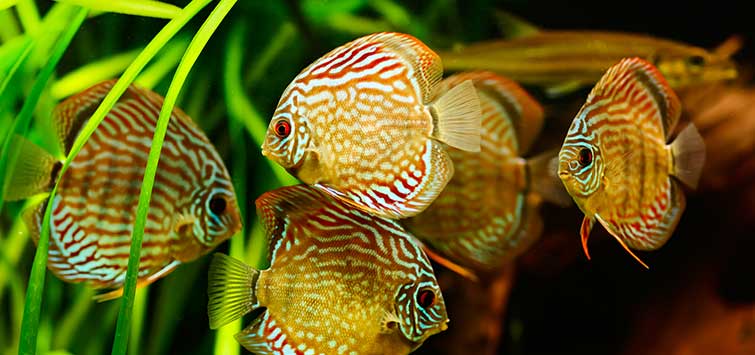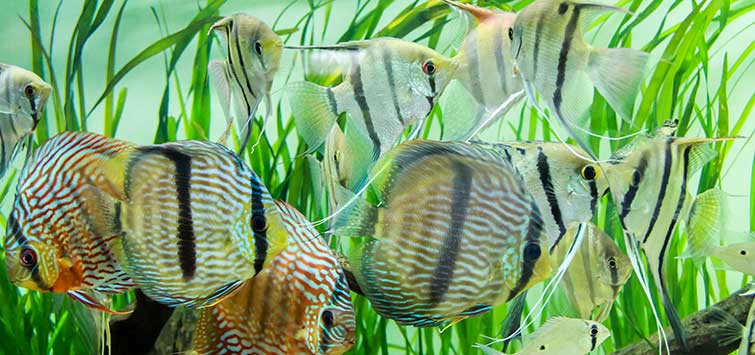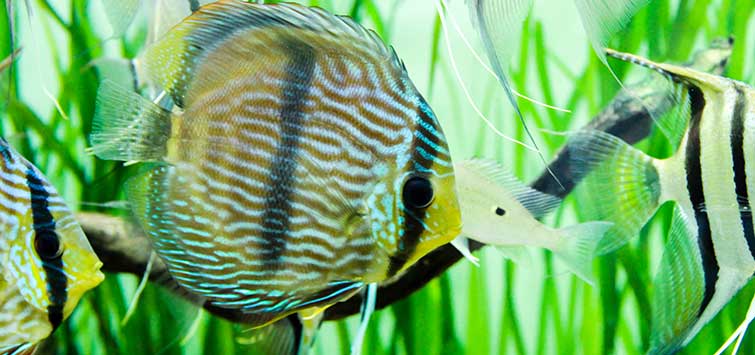Cichlidophiles: Discus: Why So Few Discus Species and How Did They Arise?
Author: Wayne S. Leibel, PhD
I have spent the last three columns (TFH March, April, and May 2007) discussing the recent findings of Kullander’s group (Ready et al. 2006) suggesting that there are three species of discus: the Heckel discus Symphysodon discus; the brown/blue discus S. aequifasciatus; and the red-spotted green discus S. tarzoo. Bleher, 2006, reviewed in my December 2006 column, also advocates a three-species model, but names and recognizes them differently: the Heckeldiscus S. discus; the blue discus S. haraldi; and the green discus S. aequifasciatus.
Three Species of Discus?
So are there really two distinct species, S. discus and S. aequifasciatus, in central/eastern Amazonia and three species overall? The western population of red-spotted green discus now designated S. tarzooby Ready et al. (2006) is both morphologically and genetically distinct from the other two species, as they demonstrated, and according to Bleher (2006) it will not successful hybridize with Heckels or blue/browns in the aquarium, though the latter two will hybridize with each other. Heckels and blue/browns are clearly separable in appearance/color pattern (though fin ray and scale counts fail to diagnostically separate them), but not genetically as their cytochrome b DNA sequence data (Ready et al. 2006) I reviewed last month suggest—both the S. discus and S. aequifasciatus versions of this gene share a very similar, nearly identical nucleotide base sequence.
Are S. discus and S. aequifasciatus one and the same species as Mazeroll and Weiss (1995) and others have suggested? (Mazeroll and Weiss actually go further and suggest that there is really only one species of discus with a wide Amazonian distribution and many morphologically distinct populations.) Or are they two incipient species on their way to becoming genetically distinct and reproductively isolated, in the midst of the actual speciation process but still able to hybridize? Or were they once geographically isolated populations that diverged genetically and morphologically and which have more recently been brought back together by changing geological forces? Now, insufficiently different genetically to hinder interbreeding, they are on their way to merging into one (genetic) species. Just what is going on?
Discus Speciation
All evolutionary models of speciation involve isolation of the candidate populations and resultant restricted gene flow between them. The isolating agent may be ecological and/or physical, with geographic isolation (physical barriers)—called allopatric (“other-place”) speciation—arguably the most effective mechanism. These barriers can be mountains that rise and “suddenly” divide a population, or a huge section of forest that somehow disappears, or in the case of fish, waterfalls, stream capture, or even the deepening water of a large lake. Discus are highly adapted to life in the Amazonian flooded forest and thus restricted in their distribution to those areas where seasonal flooding occurs: near the main stem of the Amazon River itself and in the lower reaches of its tributaries on the Amazonian floodplain. They thus present one near-continuous “linear” range which, in theory, permits the interbreeding of local populations and works against extensive speciation.
Or at least they do now. It may be that the ancestral discus population was somehow split into (at least) two discrete populations, and the two were isolated for sufficient time to have diverged genetically as evidenced by obvious colorational differences characteristic of various geographic “races.” With the barrier removed and the secondary merging of the two populations, they are now able to interbreed if they have not yet sufficiently diverged genetically while they were physically separated. However, if the physical/genetic separation has been maintained for long enough and if natural selection has further pushed the two populations apart genetically, when they come into secondary contact, they should no longer be able to breed and produce fit, fertile offspring, and are therefore good, evolutionary (reproductively isolated) species.
Given Ready et al.’s genetic data, it would seem that genetic divergence, reproductive isolation, and speciation have occurred in the case of the western red-spotted green S. tarzoo, but not for the central/eastern S. discus and S. aequifasciatus. If this is the case, then this ancestral S. tarzoo western population must have been genetically and probably physically separated from S. discus/aequifasciatusfor a long enough time to have allowed the degree of genetic divergence seen in the differing sequences of their respective cytochrome b genes (Ready et al. 2006). Is there any evidence that this western population of discus is now, or once was, physically isolated from the other two species long enough for genetic divergence and speciation to have taken place?
Geological Upheaval
Indeed, according to Lundberg, et al. (1998, “The Stage for Neotropical Fish Diversification: A History of Tropical South American Rivers” in Malabarba et al., Phylogeny and Classification of Neotropical Fishes) and cited in the Ready et al. (2006) paper, the dramatic ancient geological history of the Amazon, which includes marine incursions, ponding and lake formations, reverse flow from Pacific to Atlantic Oceans, etc., may well have split ancestral populations of discus (and other fish). The Amazon is believed to have flowed first from east to west terminating in a Pacific outlet. The initial uplifting of the Andes mountains blocked this flow and caused large-scale flood habitats in western regions of present day Amazonia, resulting, by 67 million years ago, in a diversion of drainages to the north (through Venezuela to the Caribbean Sea). Later, when the northern drainage route was cut off, about 8 million years ago, the Amazon began to flow eastward and drain into the Atlantic Ocean, as it does now.
The geological relief of the South American continent, in particular the northern Guyana Shield (Highlands) and the more southerly Brazilian Shield, framed the Amazon basin and provided the river a lowland pathway to flow through towards the Atlantic. Current distributions of discus species may reflect ancient speciation events if their preferred flood habitats were isolated prior to the change in direction of flow of the Amazon. And with that change in direction, the consequently changed flooding pattern may have reunited the isolated “species,” bringing them back into contact and allowing, if genetically possible, secondary hybridization and a genetic merging, called genetic introgression . It may be this is what accounts for the shared cytochrome b gene base sequences of modern S. discus and S. aequifasciatus.
Structural Arches
Another important geological feature besides the Andean uplift to the west, of possible importance to the discus speciation question, was the buckling of structural “arches” that formed in the drainage basin to the east of the mountains (Lundberg et al, 1998). These are subsurface and low geological features of various origin stretching for hundreds of miles and oriented perpendicular to the river channel/Amazon basin that are potential and real barriers of drainage systems, in this case the Amazon. Along the main stem of the modern Amazon River these include (from west to east) the Iquitos-Florencia arch, the Caravari arch, the Purus arch, the Monte Alegre arch, and the Gurupa Arch, which break the Amazon River into “stretches,” namely (from west [Iquitos] to east [the Atlantic]): the Amazonas, Solimoes, Middle Amazonas, Lower Amazonas, and Marajo.
The Purus arch—located between Manaus and Rio Bauana (west of Manaus)—may have provided a geographic isolating mechanism for the tarzoo/aequifasciatus divergence/speciation (Ready et al. 2006). There are no S. aequifasciatus upstream (west) of the Purus arch and only a few S. tarzoo downstream from it. This arch is believed to have formed during one of the last phases of Andean uplift, and probably breached when the Amazon changed direction. In the view of both Ready et al. (2006) and Lundberg et al. (1998), these subterranean arches may have affected organisms in the Amazonian floodplain. Each arch may have forced overlying sediments to form temporary barriers that isolated the fish faunas of each arch-delimited drainage from each other by narrowing the floodplain.
Diverging Discus Species
In the case of discus, ancestral populations of S. tarzoo were physically separated from central and eastern populations downstream, they diverged genetically (and morphologically), and over time they became sufficiently different from the other discus populations that, later, when they came into secondary contact with the similarly diverging S. discus/aequifasciatus, they remained reproductively isolated—genetically incompatible and incapable of interbreeding to produce fertile offspring. Today, where the modern Amazon still flows over these subterranean arches, the valley narrows to less than 20 km (compared to an average width of 45 km) and the water flow becomes slow and entrenched. The net result is that the water surface gradient decreases, sediment carried downstream by the river is deposited, and water flow through the channel becomes negligible, effectively blocking exchange (Ready et al. 2006).
Of course, there is no way of testing this hypothetical arch-isolation model, but studies of other fish species with near linear, continuous distributions along the Amazon River should provide support…or not. The evidence points to some common geological barrier at work, and certainly, it is possible. But the jury is still out.
Why So Few Species?
Ready et al. (2006) suggest that it is the same unusual linear, near continuous modern distribution of discus through the equatorial lowland floodplain that is responsible for the relative paucity of discus species (as compared, say, to the cichlid genera Apistogramma or Crenicichla, each with more than 50 nominal species). As mentioned several times, preferred discus habitats consist of river channels, tributaries, and associated flooded forest whose continuity should allow gene flow between populations. And with gene flow and interbreeding there is no real possibility of speciation per se. In their view, the different color/populational forms that have evolved may indicate that mate choice plays a role in their evolution. Since discus breed in the flooded-forest environment the different light conditions produced by black-, white-, and clearwater could provide a mechanism for the colorational differentiation of populations.
A similar hypothesis has been put forward for the divergent color morphs of guppy populations in Trinidad, where the tint of the water is believed to have selected for male body/tail colors and patterns that can be easily seen (or not, depending on the state of predation). In Ready et al.’s view, the S. tarzooand S. aequifasciatus distributions are consistent with the distribution of whitewater and clearwater tributaries, while S. discus are found exclusively in blackwater habitats. While gene sequence divergence of the visual pigment rhodopsin might therefore be expected to follow these different underwater visual challenges. However, it apparently did not.
What We’ve Learned
In a nutshell then, because of the high degree of highly specific adaptation to the floodwater habitats of the Amazon (ecological requirements, body modifications), discus are tied to the flooded forest habitat, which itself is continuous along the length of the main-stem Amazon. This continuous distribution allows enough hybridization and gene flow to prevent much differentiation/speciation. Only major differences between water types and large-scale geological processes (e.g., arch formation, river flow direction) have, in Ready et al.’s view, provided enough ecological/habitat difference to have allowed three (or two?) species of discus to have evolved.
Or maybe the taxonomic “lumpers” are right and there is only one discus species that varies morphologically gradually over its long continuous and linear distribution (clines/ clinal variation). We await additional scientific evidence in the form of more sampled discus, both numbers and locations, and more sequenced genes to settle the dispute. Meanwhile, there is no question that the discus, whichever population you favor aesthetically and whatever you decide call it, is still the “King of Aquarium Fishes.”
Okay, I promise: no more discus for a while. I had a nightmare about them last night.

.png?h=595&iar=0&w=2781&hash=5FD5E69473BCC22199FBFA2FB71B6033)



